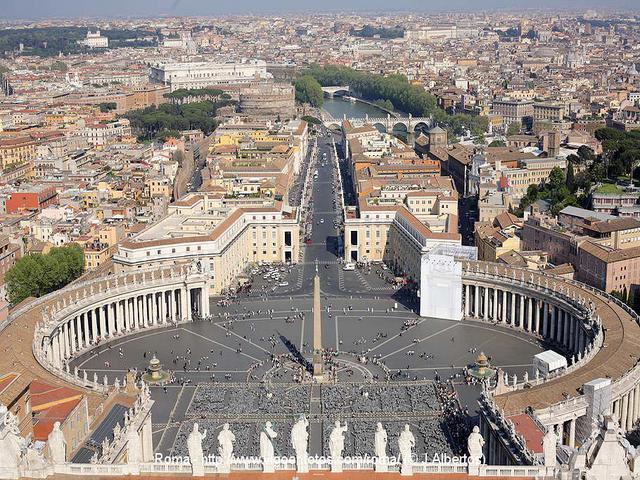St. Peter's Square

St. Peter's Square is not just a square, but a masterpiece of architecture and design that has stood the test of time. Located in Vatican City, directly in front of the iconic St. Peter's Basilica, this square is a must-see for any visitor to Rome. The square was designed by the legendary Gian Lorenzo Bernini in the 17th century, and it is a true testament to his skill and vision. The focal point of the square is the ancient Egyptian obelisk, which was brought to Rome and erected in its current location in 1586. This obelisk adds a sense of grandeur and history to the square, standing tall and proud against the backdrop of the basilica.
Surrounding the square are the famous Tuscan colonnades, which were also designed by Bernini. These colonnades create a sense of enclosure and embrace visitors in what has been described as "the maternal arms of Mother Church." The colonnades are four columns deep and were designed to accommodate large crowds, allowing as many people as possible to witness the Pope's blessings. In addition to the obelisk and colonnades, the square also features two stunning fountains. One fountain was designed by Bernini himself in 1675, while the other was designed by Carlo Maderno in 1613. These fountains add a sense of tranquility and beauty to the square, creating a peaceful atmosphere for visitors to enjoy.
The open space in front of St. Peter's Basilica was redesigned by Bernini in the mid-17th century under the direction of Pope Alexander VII. The goal was to create a proper courtyard where the Pope could give his blessings to the largest number of people possible. Bernini's design was meticulous and thoughtful, ensuring that every detail of the square served a purpose. The colonnades, in particular, were designed using the Tuscan form of Doric, the simplest order in classical architecture, in order to complement the grandeur of the basilica's façade. The scale of the colonnades is truly colossal, evoking a sense of wonder and awe in all who visit the square.
Overall, St. Peter's Square is a true masterpiece of architecture and design, a testament to the skill and vision of Gian Lorenzo Bernini. It is a place of beauty, history, and spirituality, where visitors can experience the grandeur of the Vatican City and the Catholic Church. Whether you are a history buff, an art enthusiast, or a spiritual seeker, St. Peter's Square is a must-see destination in Rome that will leave you in awe of its beauty and significance.
© ChatGPT 3.5
In the center of the ovate tondo there is an Egyptian obelisk without inscription of red granite, 25.5 meters high, supported by bronze lions and crowned by the arms of Chigi in bronze, in the 41 meters of the cross in its part superior. The obelisk was originally erected in Heliopolis, Egypt, by an unknown pharaoh. The paving is varied using radial lines in travertine, to relieve what could otherwise be a sea of cobblestones. In 1817 circular stones were placed to mark the tip of the obelisk's shadow at noon as the sun entered each of the signs of the zodiac, turning the obelisk into a gigantic sundial gnomon.
St. Peter's Square today can be reached from the Ponte Sant'Angelo along the large access of Via della Conciliazione (in honor of the Lateran Treaty of 1929). The spine (median with buildings that divided the two roads of Borgo vecchio and Borgo nuovo) that once occupied this large avenue leading to the square was ceremoniously demolished by Benito Mussolini himself on October 23, 1936 and was completely demolished on the 8th October 1937. St. Peter's Basilica was now freely visible from Castel Sant'Angelo. After the spina, almost all the buildings south of the passetto were demolished between 1937 and 1950, destroying one of the most important medieval and Renaissance neighborhoods in the city. Furthermore, the demolition of the spine canceled the characteristic baroque surprise, today maintained only for visitors coming from Borgo Santo Spirito. The Via della Conciliazione was completed in time for the Great Jubilee of 1950.
Under the Lateran Treaty, the area of St. Peter's Square is subject to the authority of the Italian police for crowd control even though it is part of the Vatican state.